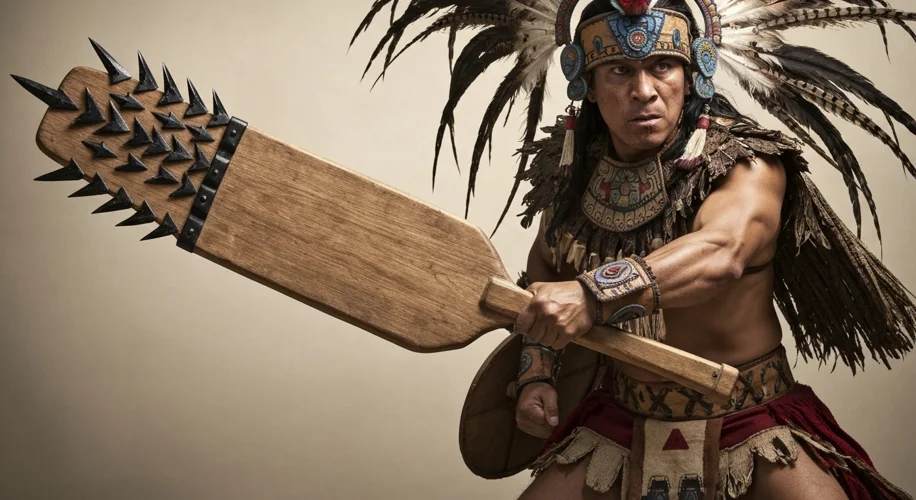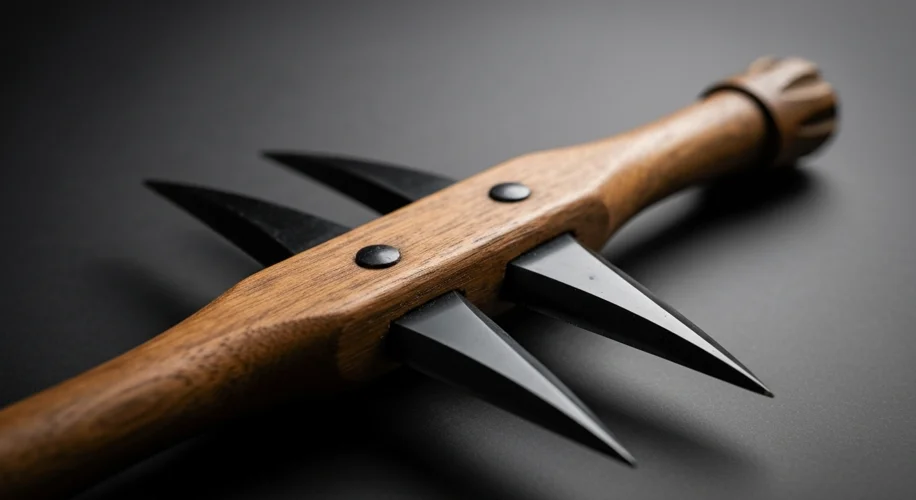Imagine a warrior, clad in vibrant plumage and intricate armor, hefting a weapon that gleams with an unnatural sharpness. This is no ordinary sword; it is the macuahuitl, a fearsome testament to Mesoamerican ingenuity and the brutal realities of Aztec warfare. Its name, derived from the Nahuatl words ‘mācuah’ (hand) and ‘uitztli’ (thorn), literally means ‘hand-stick,’ but its impact was far more devastating.
The macuahuitl was born from a unique environment and a culture deeply intertwined with conflict. In the heart of the Valley of Mexico, obsidian, a volcanic glass, was readily available. This glass, when fractured, could produce edges of unparalleled sharpness, even finer than modern surgical scalpels. However, obsidian is also incredibly brittle. The challenge for the Aztec artisans was to create a weapon that maximized the obsidian’s cutting power while mitigating its fragility.

The solution was as ingenious as it was deadly. The macuahuitl typically consisted of a wooden club, often made from lightweight yet strong woods like amate (fig tree), shaped into a flat paddle or a slightly curved blade. Into carefully carved grooves along the edges, skilled craftspeople meticulously inserted rows of razor-sharp obsidian blades. These blades were secured using a natural adhesive called tzit (yucca sap) and sometimes further reinforced with cotton or plant fibers. The result was a weapon that could inflict horrific wounds, capable of slicing through flesh and bone with terrifying ease. Unlike European swords, which were designed to thrust and cut, the macuahuitl’s primary function was to slash and hack.
At the forefront of its use were the elite Aztec warriors, the Jaguar and Eagle knights. These warriors were not just soldiers; they were also members of noble societies, trained from a young age in the arts of war. The macuahuitl was a symbol of their status and prowess. Its effectiveness was legendary. Spanish conquistadors, upon encountering the macuahuitl, were astonished by its power. Bernal Díaz del Castillo, a soldier under Hernán Cortés, described it as a weapon “fashioned like a sword, but where the sword has its blade, it has a ditch, and in this ditch they fit, from side to side, obsidian blades, which are sharper than razors.” He noted that these warriors could “cut a horse in half” with a single blow, a testament to the macuahuitl’s lethal capabilities.
But the macuahuitl was more than just a tool of destruction; it was deeply embedded in the Aztec worldview. Warfare in Mesoamerica, particularly for the Aztecs, was not solely about conquest or territorial expansion in the European sense. It was intrinsically linked to their religious beliefs and the need for sacrificial victims to appease their gods, especially Huitzilopochtli, the god of sun and war. Capturing enemies alive for sacrifice was often a greater prize than killing them outright. The macuahuitl, with its ability to wound without immediately killing, was perfectly suited for this purpose. Warriors would often aim to disable their opponents rather than deliver a killing blow, ensuring a captive for the religious ceremonies.
The introduction of European steel weapons and armor drastically changed the landscape of Mesoamerican warfare. While the macuahuitl could inflict terrible wounds, its obsidian blades, though sharp, were brittle and could shatter upon impact with a steel sword or shield. The wooden haft was also vulnerable to steel. The Spanish, with their superior metallurgy and cavalry, gradually gained the upper hand. Yet, the macuahuitl remained a formidable weapon in the hands of skilled Aztec warriors for a significant period, and its legacy persisted.
The macuahuitl represents a remarkable fusion of artistry, engineering, and cultural necessity. It stands as a powerful reminder of the diverse forms warfare has taken across human history and the innovative spirit of those who wielded it. It was a weapon that embodied the ferocity and spiritual devotion of the Aztec empire, a fearsome ‘hand-stick’ that carved its legend into the annals of conquest and survival.

